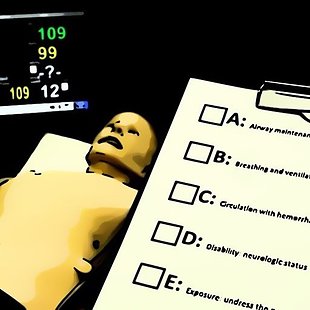Advanced Trauma Life Support
Trauma accounts for 10 per cent of the world's mortality, about 5 million victims each year. And this trend is expected to increase. Conversely, good organization of care for the injured can reduce this trend, especially in the acute phase. Since 1978, the American College of Surgeons has been trying to systematize and improve this component of care by the Advanced Trauma Life Support protocol. The interactive algorithm approaches the use of the ATLS protocol in pre-hospital care and emergency room to transport to the operating room. It describes the basic scheme of examination, securing and therapy of traumatized patients.
Review
It is a well-documented interactive case report with an analysis of a case of an accidental patient who suffered a high-energy injury. Diagnosis and resuscitation care are analyzed from the pre-hospital phase to highly specialized care in the emergency department, which acquaints the reader with the basic aspects of care for the injured patient. It allows to perceive the whole issue in a broader clinical context and understand the individual context. The basis of successful management, in this case, is compliance with the principles of the ATLS protocol at the site of the accident, as well as the correct triage and the decision on the next direction of the patient. In the pre-hospital and early hospital phase, it is necessary to follow the ABCDE assessment with basic clinical and paraclinical examinations. A novelty is the implementation of antifibrinolytic therapy in pre-hospital care for patients with suspected traumatic bleeding. As part of securing the patient in the hospital phase, it is necessary to focus on the diagnosis and treatment of internal bleeding, which is one of the basic causes of preventable death of these patients. If the patient is stable, even with proven internal bleeding, a CT scan has its place, which can accurately diagnose injuries of the retroperitoneum and hollow organs. Examination of the coagulation pathway by viscoelastic methods (ROTEM) is an example of a modern approach to traumatic patients. Their benefit lies in the targeted therapy of patients. In a hemodynamically unstable wounded person, however, activation and administration of a massive transfusion protocol and surgical arrest of bleeding - damage control surgery remain a clear priority.
Sources
Advanced Trauma Life Support: ATLS Student Course Manual. 9th. Chicago, Illinois, USA: American College of Surgeons, Committee on Trauma, 2012, 366 p. ISBN 1880696029.
Advanced Trauma Life Support. American College of Surgeons [online]. Chicago, Illinois, USA: American College of Surgeons, c1996-2020 [cit. 2020-03-25]. Available at: https://www.facs.org/quality-programs/trauma/atls





